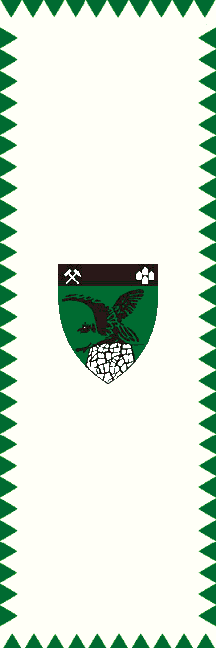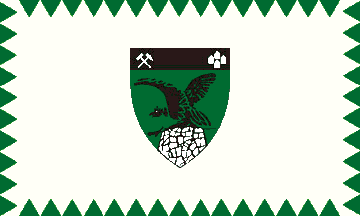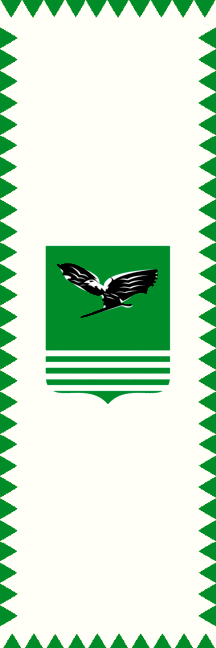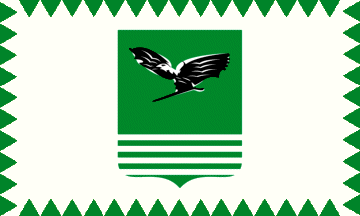
2002-
image by István Molnár, 12 January 2006

Last modified: 2006-02-11 by dov gutterman
Keywords: komarom | esztergom | tatabanya | cogwheel | lantern | wheat | hammers |
Links: FOTW homepage |
search |
disclaimer and copyright |
write us |
mirrors

2002-
image by István Molnár, 12 January 2006

2002-
image by István Molnár, 12 January 2006
See also:
Tatabánya (75,000 inhabitants) is located some 60 km west of Budapest, close to the border with
Slovakia. The city is mostly known for its brown coal mines.
Ivan Sache, 14 October 2005
Images based on modified Res. No.14/1991.(VII.18.) at Tatabánya Online.
István Molnár, 12 January 2006
Source: A magyar varosok cimerei (Coat of Arms of the
Hungarian cities and towns); 1975.
István Molnár

image by István Molnár, 12 January 2006

image by István Molnár, 12 January 2006
Square Variant

image by Arnaud Leroy, 14 October 2005
Here is the municipal flag of Tatabanya as it is flown in
Saint-Lô (Normandy). Tatabánya (75,000 inhabitants) is located
some 60 km west of Budapest, close to the border with Slovakia.
The city is mostly known for its brown coal mines. Arnaud Leroy
saw in Saint-Lô (Normandy) in August 2005 a flag representing
Tatabánya. The flag was hoisted along with the flags of
Saint-Lô and Saint-Ghislain (Belgium). Since the flag of
Saint-Lô is square, the two other ones are square too. My recent
message on Saint-Ghislain showed evidence that the municipal flag
of Saint-Ghislain used in Saint-Ghislain is not square but
rectangular. Therefore, there is no reason to believe that the
municipal flag of Tatabánya used in Tatabánya is square. The
flag is white with a green serrated border and the municipal coat
of arms in the middle. The coat of arms is green with four thin
white stripes in base and a flying black and white bird.
Ivan Sache, 14 October 2005
tatab.jpg)
2002-
image from <hu.wikipedia.org>
Here is the description from Tatabánya Online:
"The new coat of arms of Tatabánya
The new coat of arms of the Town of Tatabánya of County Rank
is effective as of 1st January 2002.
The change had become necessary because the old coat of arms had
not indicated the mining past of the town.
At the top of the new coat of arms the two knapping hammers
crossing each other on the lefthand side are designed to
symbolize this.
On the shield with green background there is a "Turul"
bird (the mythical eagle of the ancient Hungarians) with its
wings spread and its head looking to the left. It wears the Holy
Crown on the head and holds a sword in its talons with the
sword-hilt pointing toward the righthand side of the shield.
The "Turul" on the Kő Hegy (Stone Hill) is a unique
characteristic feature of Tatabánya. According to chronicle, the
conquering Hungarians destroyed Svatoplouk´s army at Bánhida.
In memory of this victory Central Europe´s largest bird statue
was set up in 1907, which has been included naturally in the coat
of arms as well.
In the upper righthand corner the four white huts as stylized
dwelling houses indicate the past of the town, i.e. its
predecessor settlements. Tatabánya was declared a town in 1947
by uniting the settlements of Alsógalla and Felsőgalla with
German population, Bánhida with Slovak inhabitants and the
mine-head camp.
The new coat of arms was designed by OLÁH György graphic artist
born in Tatabánya, a Munkácsy Prize winner, and university
lecturer at Budapest University of Fine Arts.
The escutcheon is a pointed shield with curved sides. The
heraldic figure of "Turul" rests on the black-white
base of shield which is a symbolic representation of the base of
statue found on the Kő Hegy. The heraldic figure occupying the
middle part of the shield is black against a green (pantone 347)
background."
Dov Gutterman, 18 October 2005